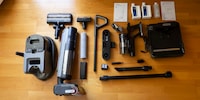

Battle of the bagless vacuum cleaners – a review
Bagless stick vacuums with rechargeable batteries promise nigh unlimited freedom. But how good is their suction? I compared five models.
Doing a fair comparison of five vacuum cleaners is no easy feat. Each model has its own peculiarities, special functions and special equipment. And when it comes to suction power, the manufacturers provide a jungle of at times quite adventurous specifications. Watts, volts and pascals – these are all highly abstract units that help no one and are difficult to compare.
That’s why I opted to test these vacuums in practice. That is, how much flour, breadcrumbs and coffee beans do they pick up on the highest setting? I tested them on the floor and on carpet at the highest suction level, as it offers the best comparison. The lower suction levels proved so poor on all the models that my floor remained excessively dirty.
When it comes to bagless vacuum cleaners, how the dirt container handles is important to me. I need to be able to empty it without making a big mess, otherwise I find it unusable. In addition, the dirt shouldn’t get caught in the dust bin.
The battery, on the other hand, isn’t an important criterion for my test, as all the vacuum cleaners I tested have enough power for a standard apartment. Each battery can also be replaced, meaning you can use several charged batteries to clean if one isn’t enough.
The competitors
Special features
If vacuum cleaners were superheroes, the features I mention below would be their superpowers. Manufacturers will equip their vacuum cleaners with more – or less – useful features in the hopes they’ll stand out from the crowd. I award a maximum of five «superhero points» per vacuum cleaner. This assessment is quite subjective; you may value other superpowers more than I do.
Miele Triflex – The Transformer
With the Miele, I can mount the suction mechanism including the dirt container either at the top or bottom of the tube. This shifts the weight; vacuuming is easier with the weight at the bottom. However, the Triflex doesn’t fit under the piece of furniture I used in my test.
🦸🦸🦸
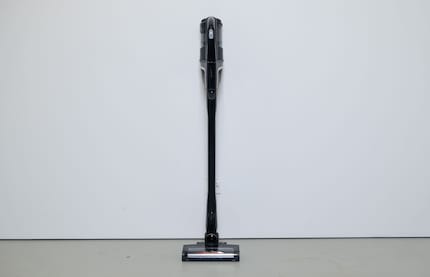
Source: Simon Balissat
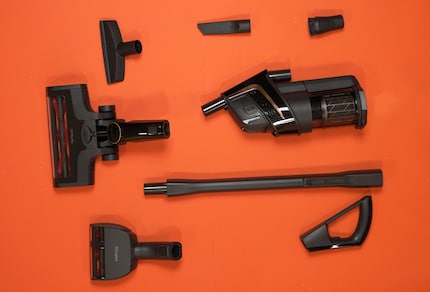
Source: Simon Balissat
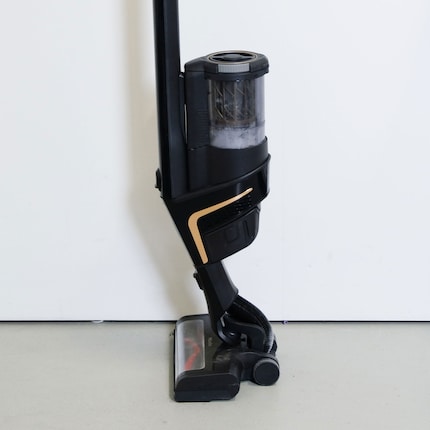
Source: Simon Balissat
Rowenta X-Force – The Limber One
The X-Force has a tube with a joint and allows you to vacuum under furniture without having to resort to yoga. I easily got under the cabinet in my test. This is especially handy if you have a lot of raised furniture under which you need to vacuum.
🦸🦸🦸
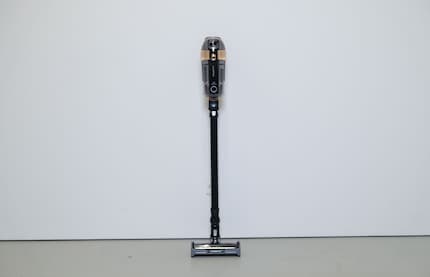
Source: Simon Balissat
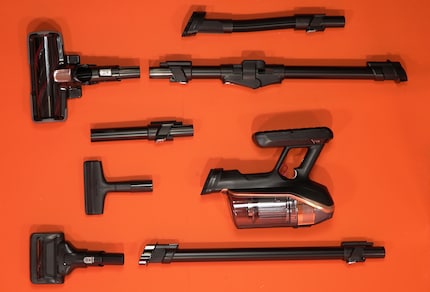
Source: Simon Balissat
Electrolux Ultimate 800 – The Sturdy One
The Ultimate comes with a stand that simultaneously charges the battery. That’s great if you have the space for it and can power it wherever you keep it. If you want to keep it in your cleaning closet, though, the bottom of the stand can prove space-consuming and useless.
🦸
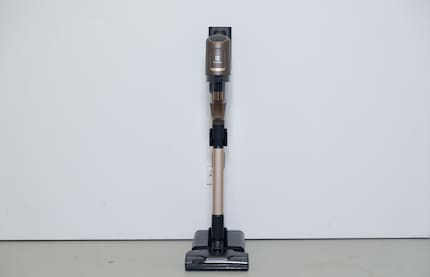
Source: Simon Balissat
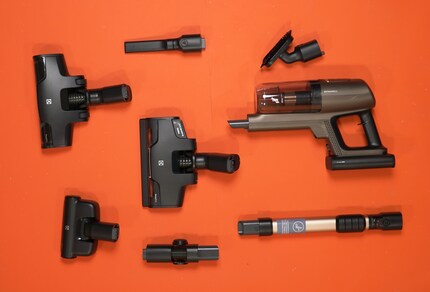
Source: Simon Balissat
Philips XC8045/01 Speed Pro Max – The Minimalistic One
Less is more. Philips refrains from including various brushes, which can be a good call. The Speed Pro Max vacuums floors and includes an upholstery brush; nothing else. This saves unnecessary plastic parts from gathering dust in your cleaning cupboard.
🦸🦸🦸
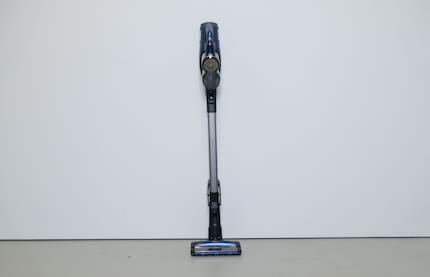
Source: Simon Balissat
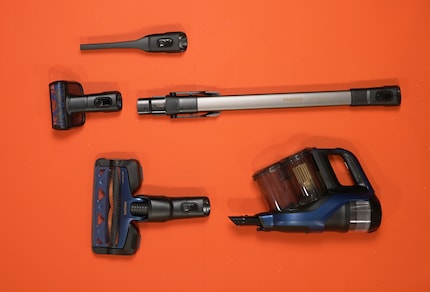
Source: Simon Balissat
Dyson V15 Detect Absolute – The Futuristic One
This Dyson vacuum features a laser beam that lights the way, ensuring you find every last speck of dust. In my test, this did work well on completely flat floors. However, this feature saves you neither time nor effort, so it’s by no means a must-have.
The Dyson also displays information on the size of the particles you vacuum, which is rather useless.
🦸🦸
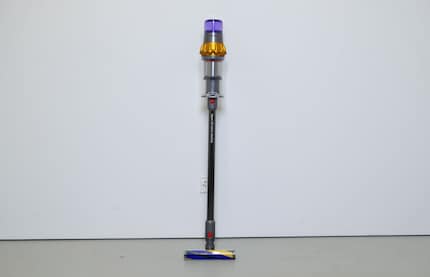
Source: Simon Balissat
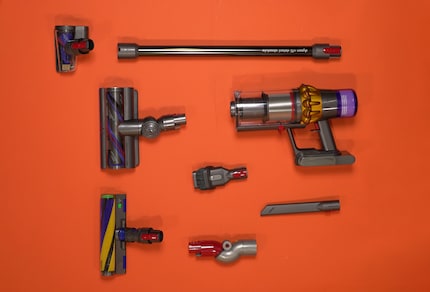
Source: Simon Balissat
Suction power
To test suction, I spread 50 grammes of flour, then 50 grammes of breadcrumbs, and, finally, 50 grammes of coffee beans on the floor and carpet. I then vacuumed it up and weighed the contents of the dust bin to see how much the vacuum cleaner picked up. I drove over the same spot a maximum of four times. I left whatever wasn’t picked up on the floor, though I did beat the rug between tests. Still, there’s a certain inaccuracy to this method.
I went with five-gramme increments for my grading scale: vacuum cleaners that collected between 50 and 45 grammes received the top score; vacuum cleaners that collected between 44.9 and 40 grammes received a one-point deduction; and so on.
Suction power on hard floors
Each vacuum was able to handle the coffee beans, though I had to lift the nozzle up a bit on all of them to make them work. Flour and breadcrumbs also proved no problem for all the models. The Philips and Dyson had a little more trouble with the flour; the floor was clean, but some flour was stuck in the nozzle.
Scores
(the maximum score is five; one point is deducted for every five grammes)
Miele, Electrolux, Rowenta
🧹🧹🧹🧹🧹
Dyson, Philips
🧹🧹🧹🧹
Suction power on carpet
Here, Rowenta, Miele and Electrolux pull ahead, while Dyson and Philips lose out. The Rowenta vacuum cleaner in particular gets everything out of the carpet, but at the expense of battery power. But more on that later. At the bottom of the ranking is the Philips, which especially struggled to get all the flour out of the carpet.
Scores
(the maximum score is five; one point is deducted for every five grammes)
Rowenta, Miele, Electrolux
🧹🧹🧹🧹🧹
Dyson, Philips
🧹🧹🧹🧹
Emptying the dust container
Bagged vacuum cleaners are not sustainable, they’re impractical and the bags are expensive. The bags all end up in the trash, and then you have to remember to buy the fitting replacement. Their only advantage? Hygiene. Any dirt you vacuum is contained in the bag, which is contained in the trash can. This can’t always be said of bagless vacuum cleaners. The dust bins tend to either be difficult to remove or come loose so easily that they plummet to the ground if you don’t hold on tightly enough. Hence, here are my ratings for how easy the dust containers are to empty.
Dyson
Dyson’s patent is time-tested and works very well. There’s a handle that opens a flap on the lower part of the dust bin. It can jam sometimes, but works perfectly once you get the hang of it. And because you don’t have to slide out the bin from the housing, it won’t slip out of your hand. This proved the best solution in practice, so I gave it five points.
🧹🧹🧹🧹🧹
Miele
Miele uses a similar mechanism to Dyson. However, you need to remove the container. If not closed properly, the flap may already open as you remove the container, spilling the contents right back onto the floor. After a few uses, you should get the hang of it. But I’m deducting one point for this.
🧹🧹🧹🧹
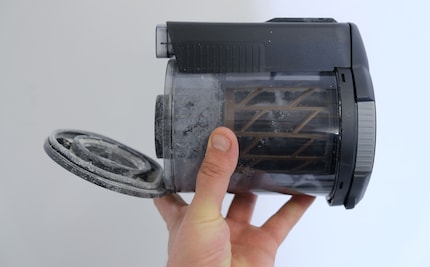
Source: Simon Balissat
Philips
Philips also relies on a container, but you first have to remove a lid before you can dump the contents into the trash. Again: four points.
🧹🧹🧹🧹
Rowenta
Rowenta has integrated the air filter into the lid of the container. This isn’t ideal, as it drags out dust and lint that inevitably end up next to, instead of in, the trash. Three points.
🗑🗑🗑
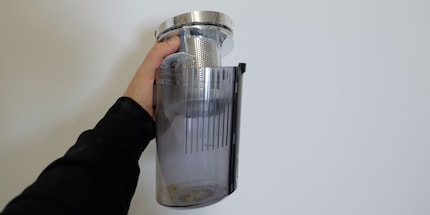
Source: Simon Balissat
Electrolux
At first, I thought that my device was defective. As I was removing the container, a round filter fell out. I could only get it back with difficulty after several attempts. In addition, I first had to fold out a metal handle and then remove the entire air filter before I could finally empty the container. This was by far the most cumbersome solution, hence it gets only two points.
🗑🗑
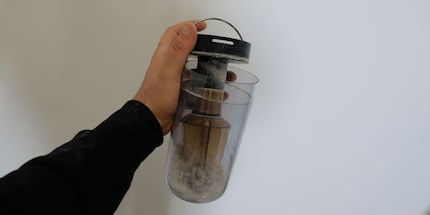
Source: Simon Balissat
Upon request, Electrolux provided the following statement:
[Removing and emptying the dust container] is a point we’re taking into account in the further development of our appliances.
Battery
I can’t judge the actual runtime, as I only recorded the battery levels after my testing. In general, carrying out the tests took about five minutes per vacuum cleaner at full suction power. After that, I noted the information from the display. The data should be taken with a grain of salt; hence, I’m awarding a maximum of two points for battery. All the vacuum cleaners tested should easily get through a lightly soiled, 90-square-metre apartment on a single charge. The actual runtime is therefore irrelevant.
I have to give Rowenta a special mention. Its highest level outperformed the other vacuums by far. Most notably, the X-Force got every last crumb out of the carpet. Mind you, at the expense of the battery, which, in turbo mode, lasts just about five minutes.
Philips
🔋🔋
Miele, Electrolux, Dyson
🔋
Rowenta
0
Final scores
First off, all the vacuum cleaners I tested performed well. Each has sufficient suction power for everyday use, so choosing the right vacuum cleaner comes down to your personal preferences.
If you’ve got mainly carpet at home, the model from Rowenta is perfect for you. On hard floors, on the other hand, you’ll benefit from Dyson’s laser function. The Philips also finishes as a mid-segment product with its minimalism and functionality. Which is the best all-rounder and test winner? The Miele Triflex. It does nearly everything right, apart from not reaching under furniture quite as well as the other models. The Electrolux Ultimate finishes last, mainly because emptying the dust container is an awkward experience and the charging stand takes up a lot of space.
Header image: Simon Balissat
When I flew the family nest over 15 years ago, I suddenly had to cook for myself. But it wasn’t long until this necessity became a virtue. Today, rattling those pots and pans is a fundamental part of my life. I’m a true foodie and devour everything from junk food to star-awarded cuisine. Literally. I eat way too fast.





